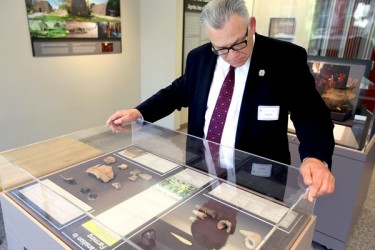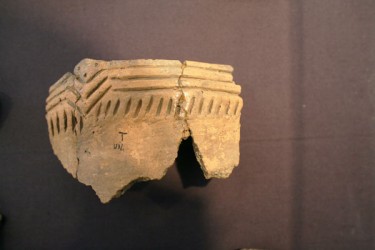Article Origin
Volume
Issue
Year
University of Toronto officials no longer have to wonder about what to do with the glassed-in area in the lobby of their Anthropology Building.
That’s because a 540-foot square room in the lobby now houses a permanent exhibit called Uncovering Our Past: First Nations in Toronto.
The exhibit had its official opening on May 11. The free exhibit is open to members of the public. Visitors are welcome Monday through Frida, from 9 a.m. until 4 p.m.
“This is a wonderful opportunity for us,” said Susan Pfeiffer, a professor at U of T’s anthropology department. “We hope people will see it through the window and stop by.”
The exhibit consists of about 100 artifacts, housed in four main displays.
Many of the artifacts come from the collection of items discovered during excavations by U of T students and faculty. Some of the excavations date back to the 1940s.
The excavations done by U of T reps were on sites throughout southern Ontario, when they were the homes of Huron-Wendat ancestors.
“We really chose the best things we had (in our collection),” Pfeiffer said, adding the exhibit will possibly soon be added to U of T campus tours.
Pfeiffer said officials with U of T’s First Nations House, located nearby on the campus, will also be promoting the exhibit. But it’s difficult to speculate how many people will pop in to have a look.
“The more the better,” she said.
Pfeiffer said artifacts in the U of T collection had not been properly displayed before. The school’s anthropology department moved into its current building, located at 19 Russell Street (near College Street and Spadina Avenue), five years ago. Prior to that the building was used by U of T’s pharmacy department.
Before the idea to house the exhibit in the lobby popped up, department officials often wondered what to do with the open space.
Not all of the artifacts on display, however, are real.
“Some are casts of authentic early Paleo-Indian excavations,” Pfeiffer said. “We know what they look like.”
The four main displays in the exhibit are arranged in a clockwise direction.
For starters, there’s the display of artifacts from the Paleo-Indian Period, which was 8,500-11,000 years ago. Besides a caribou cranium and other bones, there’s also a cast of a mammoth tooth, from the extinct elephant, dating anywhere from 4,500 to 4.5 million years ago.
The second display case features artifacts including goose bones and projectile points ranging from the Archaic Period (2,900-8,500 years ago) to the Early and Middle Woodlands Period, which was from about 1,500-2,900 years ago.
The next display is from the Lake Woodland Period, 600-1,600 years ago. This depicts the transition to farming period. This display includes numerous pieces of carbonized maize.
The fourth display is titled People of the Longhouse and features artifacts from 350-600 years ago. Besides various pipe fragments, this display includes projectile points and beads.
Though it is not part of the four displays, a key item in the exhibit is a wampum, which is framed and on display on a wall. It was presented to the university this past December by Huron-Wendat Nation Grand Chief Konrad Sioui.
The wampum depicts people holding hands, symbolizing the current and future partnership between U of T and the Huron-Wendat people.
Once officials from the Huron-Wendat Nation find a place and method to properly handle it, U of T officials will be passing on some human remains and other artifacts for reburial.
Pfeiffer said her favourite part of the exhibit is the wampum.
“It’s directed towards the future,” she said. “It emphasizes the story here is not just about the past.”
The wampum was presented to the school after a Memorandum of Understanding was signed by both the school and Huron-Wendat Nation officials.
Luc Laine, the charge d’affaires for the Council of the Huron-Wendat Nation, was among those that attended the exhibit’s opening.
“I think it’s going to be a win-win result,” he said. “I hope many people will stop by and come in and take the time to learn. It’s public education.”
Laine was especially impressed with some of the arrows on display.
“I don’t know why - maybe because I’m a hunter myself,” he said. “Those are real pieces of art. They didn’t have the tools we have today.”
Photo Caption:
Susan Pfeiffer, Department of Anthropology, U of T (left), Barbara Harris, Councillor – Six Nations of Grand River, Luc Laine, Huron-Wendat Nation, Joanne Thomas, Land Use Officer/Consultation Point Person – Six Nations Lands and Resources.
- 2985 views




